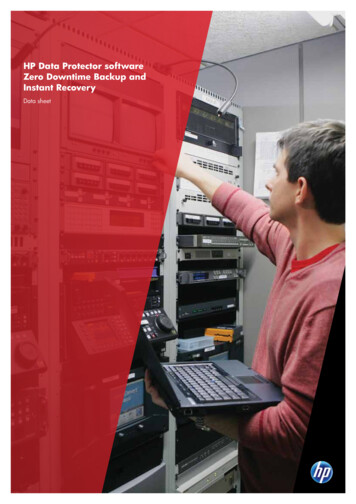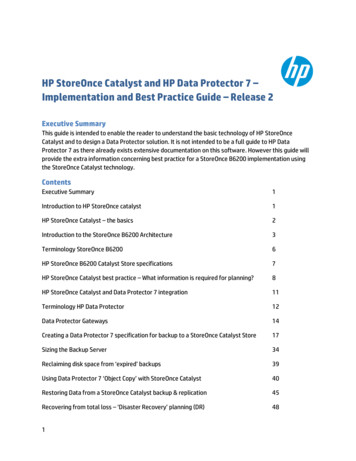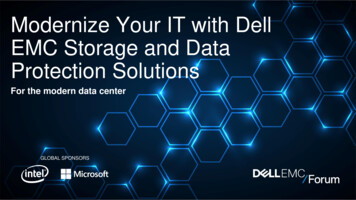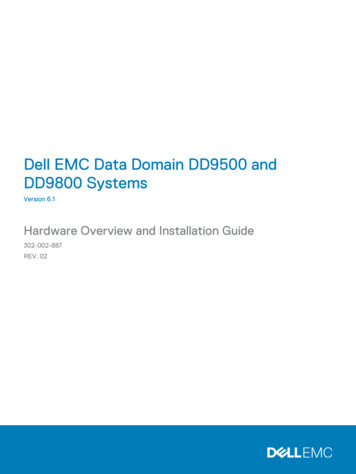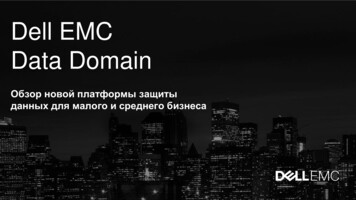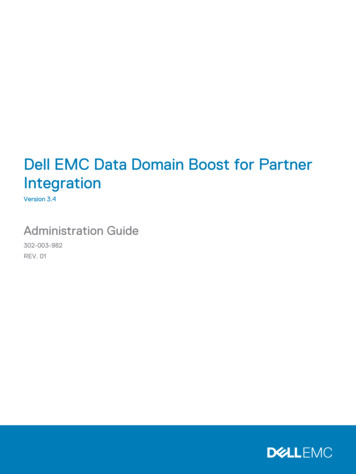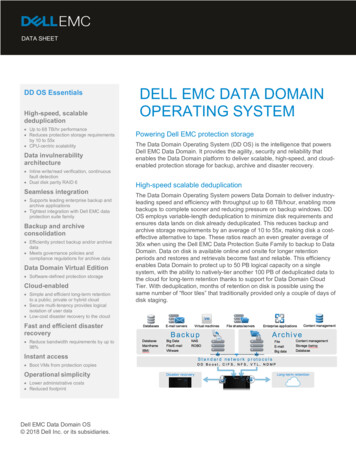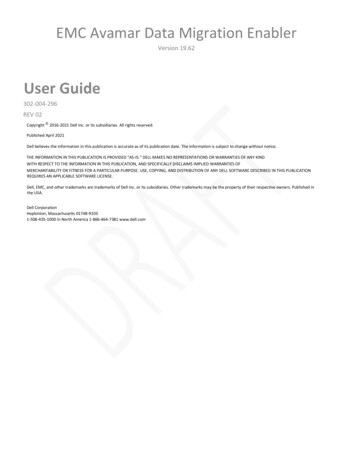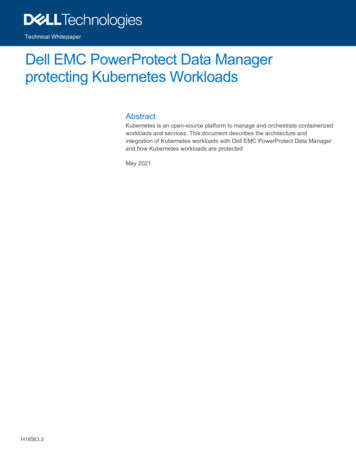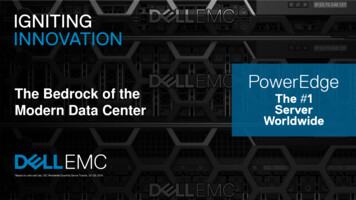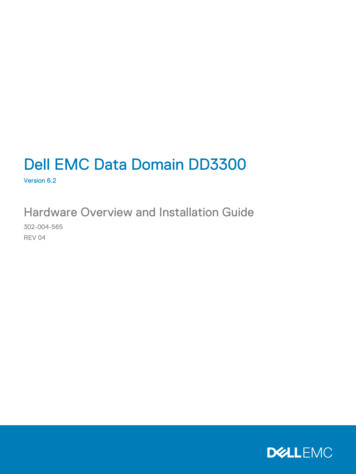
Transcription
BrochureApplication Modernization and ConnectivityData Protector andDell EMC Data DomainBoost Integration
BrochureData Protector and Dell EMC Data Domain Boost IntegrationThe Drivers of Data GrowthEnterprises large and small are embracing technology wherever possible as a catalyst for the creation of new opportunities. While the drivingfactor at one time was maintaining a competitive edge and consolidating data center infrastructure, today the adoption of new technologyis the catalyst for capturing new markets, creating new products, andlaunching other areas of revenue growth. Regardless of how and whyyou bring a new technology on board, the result is typically the same:more information is created that has to be categorized based on its importance and then aligned with a suitable backup and recovery processto manage data loss and disaster recovery.As the rate of technology adoption continues, it deepens our dependency on digital data, which in turn drives unabated data growth.This never-ending cycle results in the need for more storage, greatermanagement and oversight, faster throughput, more stringent governance, and immediate access, as well as having a loss-mitigationstrategy. These challenges are amplified by a mobile workforce thatquickly adopts new technologies, creating more responsibility for ITprofessionals and impeding their abilities to deliver revenue-generatingsolutions to the business.The need for 24x7 access on a global scale is another challenge in themodern data center, requiring the scale and elastic infrastructure necessary to address continually changing user and market demands andprovide immediate access to any and all organizational data at any time.The ability to meet these end user expectations can set an organizationapart from its competition.With each item on this long list of challenges and requirements, backup andrecovery (a core competency of IT) often compete for physical and humanresources, and it is often the heaviest casualty of unabated data growth.How Data Growth Complicates Backup and Recoverydepartments choose the right infrastructure and the right backup andrecovery strategy, especially when data exists at scale. At the end ofthe day, the IT department remains responsible for ensuring the survivability of their organization’s information from any kind of event, such asdisasters, corruption, or system failures (logical, physical and/or virtual).And with so much data to be considered, growing at an unabated rate,one common solution that is often chosen is deduplication.The Effects of Deduplication on Organizational DataDeduplication has become one of the most important storage optimization techniques to combat data growth and is the process of examiningand comparing data that is already being stored to determine if it is identical. Specialized deduplication engines are often implemented basedon mathematical algorithms that are unique for each vendor. In practice,the algorithm is applied to data segments and results in what are commonly referred to as hash values or hash codes. When the comparisonof two data segments result in the same hash code, they are determinedto be identical and the engine replaces the duplicate with metadata thatlinks it to the original. By processing and comparing chunks of data toisolate and store only the unique segments, deduplication can reduceinfrastructure demands by as much as 80 percent, depending upon theworkload and structure of the data.Combating Data GrowthKeeping data volumes at bay is both an active and time-consuminginitiative. Deduplication certainly offloads and automates aspects of thisinitiative and speaks to why the adoption of deduplication has becomeso pervasive. But the pervasiveness is not limited to adoption, nor is ita feature/function limited to the primary storage array upon which theorganizational data resides. The need for deduplication extends to allplaces where data resides. More importantly, it adds efficiency to thebackup and recovery strategies that are put into place.Managing your information can be more complicated, just due to thesheer rate of growth—doubling every 12 to 18 months. This drives CIOsto continually look for infrastructure features that can minimize datagrowth, via storage arrays, networking infrastructure, I/O accelerators,etc. And while these approaches have their merit, they often result inpushing the bottleneck to different locations within the data center,where investments and advancements have not been applied.Boost Backup and Recovery with DeduplicationIdentifying backup and recovery solutions that can simplify the dataprotection process and unburden the IT organization can be a challenge, particularly given that data grows and vacillates in stages ofimportance, relevance, and criticality. For this reason, it is key that ITAnother benefit of deduplication is the impact to the recovery process.The use of pointers to the unique data does not change the restorepoints. In other words, every point from which the data can be restoredsimply references the unique data extending the restore process and2Deduplication processes offer a powerful rung in the backup and recovery ladder that allows you to increase the speed of your backup processby reducing the amount of storage space required for both the production data and its related backup sets. By storing a single set of uniquedata with logical pointers to and from all other duplications of the samedata, the overall capacity of the backup infrastructure is optimized.
reducing errors associated with manually managing the way the backuptarget media handles the deduplication of data.The best possible solution is to deploy IT infrastructure with components that take full advantage of deduplication—at the primary storagearray, in the backup solution, and with the backup target. Micro Focus Data Protector software offers deduplication as a core value of the product, allowing you to choose where the deduplication occurs; either atthe edge where the data is created, at backup servers, or completelyoffloaded to the D2D target.As organizations continue to ingest multi-vendor solutions throughacquisitions, organizational policy, hardware reuse, etc., having supportfor a heterogeneous storage environment at the backup software layeris key.A Heterogeneous ApproachThrough the integration of Data Protector and Dell EMC Data Domainsystem, you can implement a heterogeneous approach and use deduplication in your backup and recovery process. Data Domain is a marketleader in D2D storage that offers a high-speed deduplication engineknown as Data Domain (DD) Boost. By extending Data Protector via integration with the DD Boost, your backup solution can use a commondeduplication algorithm at the edge, at the backup server, or target D2Ddevice when using the Data Domain system. The solution allows youto achieve a consistent and faster backup and recovery experience,regardless of the application or data tier.About Dell EMC Data Domain BoostData Domain Boost software significantly increases performance, reduces resource requirements, and simplifies management. With DDBoost, parts of the deduplication process are distributed to the backupserver or application clients, enabling it to compress and send onlyunique data segments to a Data Domain system. This enables 50 percent faster backups and reduces network bandwidth requirements byas much as 80-99 percent.In addition, DD Boost provides advanced load balancing and failover,which further improves throughput and resiliency. With advanced loadbalancing and failover, you can aggregate multiple transport links on theData Domain system into a single group so multiple links appear as oneto the backup application. The Data Domain system then transparentlybalances the backup load between links in the group. In addition, theautomatic link failover mechanism keeps backup systems operationalin case of temporary network glitches.www.microfocus.comData Domain Boost provides advanced integration with the majority ofthe backup application market and industry leading enterprise applications. For the latest updates on the product please check out emc.com/data-protection/data-domain.htm.About Micro Focus Data ProtectorData Protector, an enterprise grade backup and disaster recovery solution, enables you to seamlessly protect and harness data from edge ofthe network to the data center and the disaster recovery site—acrossphysical, virtual, and cloud environments. Designed to support the largest and most heterogeneous enterprise environments, a single DataProtector instance can protect thousands of clients and hundreds ofbillions of files, and run 100,000 sessions per day.With unique capabilities such as integrated cloud backup, enhanced automated disaster recovery, zero downtime backup, instant recovery, anddown-to-the-second application recovery, Data Protector allows you toincrease storage efficiency and backup and recovery performance, instantly recover your mission-critical applications, and turn your backupdata repository into an information advantage. From a single pane ofglass, Data Protector allows you to fully leverage your data asset investment across premise, hybrid, and cloud infrastructure to reduce backupand recovery windows and increase business application performance.Simple yet powerful snapshot functionality frees you from restrictivebackup windows while instant recovery capability enables flexibledown-to-the-second recovery through a simple-to-use graphical userinterface. One-touch setup for off-site backup on the cloud protectsdata on one of the world’s largest and most secure private cloud providing enterprise-class edge-to-cloud protection while reducing CAPEXand OPEX.Industry Collaboration Boosts Customer SatisfactionOrganizational IT leadership typically base their solution deploymentdecisions on a number of criteria, one of which is the degree of flexibility that a chosen solution may offer the existing infrastructure. Thegoal is to make the solution work with and for the infrastructure, not thereverse. As a core IT function, Data Protector helps you coordinate andorchestrate your backup and recovery operations, from how, to where,to what performance features you use.A key question for many IT professionals is how to minimize the amountof data backed up and transferred over the network. Data Protector software provides its own native deduplication algorithm; While the deduplication feature of Data Protector addresses most user requirements,3
BrochureData Protector and Dell EMC Data Domain Boost Integrationthere are some instances where the use of existing infrastructure features is more advantageous to the customer. By working with industrypartners, such as Dell EMC, Micro Focus is able to remain committed toaddressing market challenges with solutions that address critical challenges. We can also enable you to continue running in heterogeneousenvironments, with integration and support for the leaders in the datacenter ecosystem.Data Protector’s integration with DD Boost technology enables customers to solve a market challenge by offering more choices to solve thebackup and recovery requirements of their organization. The integration allows users to specify a Data Domain target when setting up thebackup configuration and also to determine where the deduplicationcould occur.Features: Data deduplication at the point of data creation via a DDBoost-enabled Data Protector media agent installed on theapplication server Works in conjunction with Data Domain Boost’s distributedsegment processing, which distributes the deduplicationprocess between the DD Boost-enabled media agent andthe Data Domain system Client-side deduplication is supported with Microsoft Windows,HP-UX, Linux, AIX and Solaris Operating Systems. Data Protector’s implementation results in single-clickconfiguration without device selection per backup client Data Protector can leverage Data Domain Boost asa high-performance deduplication backup targetUsing Data Domain’s deduplication algorithm, available via DD Boost,Data Protector supports deduplication in three locations: client-side,backup server, or target device. Each of these, along with their advantages and considerations, are explained below:Benefits:Client-Side Deduplication Potential reduction in the time required for the backup, especiallyThe term “client-side” is a form of deduplication that is enabled at thepoint the data is created and before it is transmitted over the networkto the target backup device. With DD Boost, Data Protector can be configured for client-side deduplication to make sure that only unique datais used during backup. An example of this implementation can be seenin Figure 1. Higher efficiency in network utilization by only sending unique datato the Data Domain systemon high latency and limited bandwidth connections between coredata centers and remote locations Improved backup and replication Service Level Agreement (SLA)definitions based on lower network traffic and predictable backupsets at the point at which the data is created Same deduplication algorithm as the target, via DD Boost, results ina standardized approach tailored to the specific backup needs andinfrastructure capabilitiesBackup Server DeduplicationData ProtectorBackup ServerDedupe TransferApplicationServerFigure 1. Client-side deduplication implementation4DD Boost EnabledDell EMC Data DomainWhen bandwidth considerations are outweighed by the need for all resources to support the workload of the client-side system, the backupserver can handle the deduplication process. In this architecture, theraw backup set is transmitted from the source to the backup serverwhere the DD Boost-enabled Data Protector media agent is running. Onthe backup server, the Data Domain deduplication algorithm is used toverify that only unique data is transferred to the Data Domain system.An example of this implementation can be seen in Figure 2.
Data ProtectorBackup ServerDedupe TransferDD Boost EnabledDell EMC Data Domainprocess can be offloaded to Data Domain, the target device. In thisarchitecture, the raw backup set is transmitted from the source to thebackup server, and from backup server to the Data Domain system,without consideration for duplicate data in the backup set. On the targetdevice, the same Data Domain deduplication algorithm is used to makesure only the unique data is stored in the system. An example of thisimplementation can be seen in Figure 3.ApplicationServerNon-dedupe TransferFigure 2. Backup server deduplication implementation.Features:Data ProtectorBackup Server Data deduplication at the point where the backup process ismanaged via a DD Boost-enabled Data Protector media agentinstalled on the backup server Works in conjunction with Dell EMC Data Domain Boost distributedsegment processing, which distributes the deduplicationprocess between the DD Boost-enabled media agent and theData Domain system Backup server deduplication preserves the physical resourcesat the source for resource-intensive workloads Data Protector can leverage Data Domain Boost as ahigh-performance deduplication backup targetBenefits: Higher efficiency in network utilization by only sending unique datato the Data Domain system Potential reduction in the time required for the backup, especiallyon high latency and limited bandwidth connections between thebackup server and the target backup device Improved performance of the client-side infrastructure whereresources are allocated for the production workload anddeduplication is offloaded to the backup server Same deduplication algorithm as the target, via DD Boost, results ina standardized approach tailored to the specific backup needs andinfrastructure capabilitiesTarget-Side DeduplicationWhen bandwidth considerations are out-weighed by the need for all resources to support both the client-side system workload and the backupserver handling competing workload demands, the deduplicationwww.microfocus.comDD Boost EnabledEMC Data DomainApplicationServerNon-dedupe TransferFigure 3. Target-side deduplication implementationFeatures: Inline deduplication at the point where the backupset is stored and managed as part of the data protectionlife cycle Target-side deduplication preserves the physical resources atthe source and the backup server for resource-intensiveparallel workloadsBenefits: The solution provides higher efficiency in the resource utilization ofthe backup systems by offloading the deduplication effort to theData Domain system Improved performance of the client-side infrastructure whereresources are allocated for the production workloadData Protector Managed ReplicationIncreasing frequency of catastrophic events like hurricanes, floods, fire,etc. have raised the urgency to have disaster recovery (DR) procedures.One of the most crucial steps for DR is to have a copy of the data ata remote site. To improve the reliability of disaster recovery and meetstringent recovery time objectives (RTO) imposed by the business, organizations are increasingly replicating backups to create this offsitecopy of their critical data. Reducing the amount of backup and archive5
BrochureData Protector and Dell EMC Data Domain Boost Integrationdata replicated through deduplication and compression reduces thenetwork bandwidth required, and makes replication over existing networks economically viable.to be capable of restoring those backups in the event of the completefailure of the original site.Data Protector Servers sharereplication details to facilitate recoveryDD Boost EnabledEMC Data DomainData ProtectorSite A Cell ManagerData ProtectorSite B Cell ManagerDD Boost EnabledDeduplicatedReplicationData ProtectorBackup ServerDedupe TransferDD Boost EnabledEMC Data DomainApplicationServerNon-dedupe TransferDD Boost EnabledEMC Data DomainDD Boost EnabledEMC Data DomainPossible restore pathsFigure 4. Data Protector managed replicationDedupe TransferNon-dedupe TransferFeatures: Managed backup session replication using DD Boost allows thebackup software to control the replication on a per-file basis.When integrated with DD Boost, the backup software’s users canconfigure policies to selectively replicate the individual backupimage or dataset to another system after completion of the backup Managed backup session replication directly transfers a backupimage from one Data Domain system to another, one at a time onrequest from the backup software The backup software keeps track of copies, allowing easymonitoring of replication status and recovery from multiple copiesBenefits: Backups are protected from Data Domain failure at the primarylocation Backups can be restored from either the primary or replicatedbackup targetData Protector Automated Replication SynchronizationTo protect against full site loss at a location, Data Protector providesAutomated Replication Synchronization utilizing Data Domain BoostReplication. This allows a backup server at a DR location to be immediately aware of backups that have been replicated to that location and6Possible restore pathsFigure 5. Data Protector automated replication synchronizationFeatures: Data Protector servers share replication information tofacilitate recovery Managed backup session replication directly transfers a backupimage from one Data Domain system to another, one at a time onrequest from the backup software The backup software keeps track of copies, allowing easymonitoring of replication status and recovery frommultiple copiesBenefits: Backups are protected from full site failure Disaster recovery is easily implemented Business continuance in disaster situationsSummaryMicro Focus and Dell EMC have teamed up to bring together DataProtector and Data Domain Boost to enable you to deploy a commondeduplication approach at the source, the backup server, or the target
when combined with a Data Domain system. With this approach, youexper
Data Domain is a market leader in D2D storage that offers a high-speed deduplication engine known as Data Domain (DD) Boost. By extending Data Protector via in - tegration with the DD Boost, your backup solution can use a common deduplication algorithm at the edge, at the backup server, or target D2D device when using the Data Domain system.
